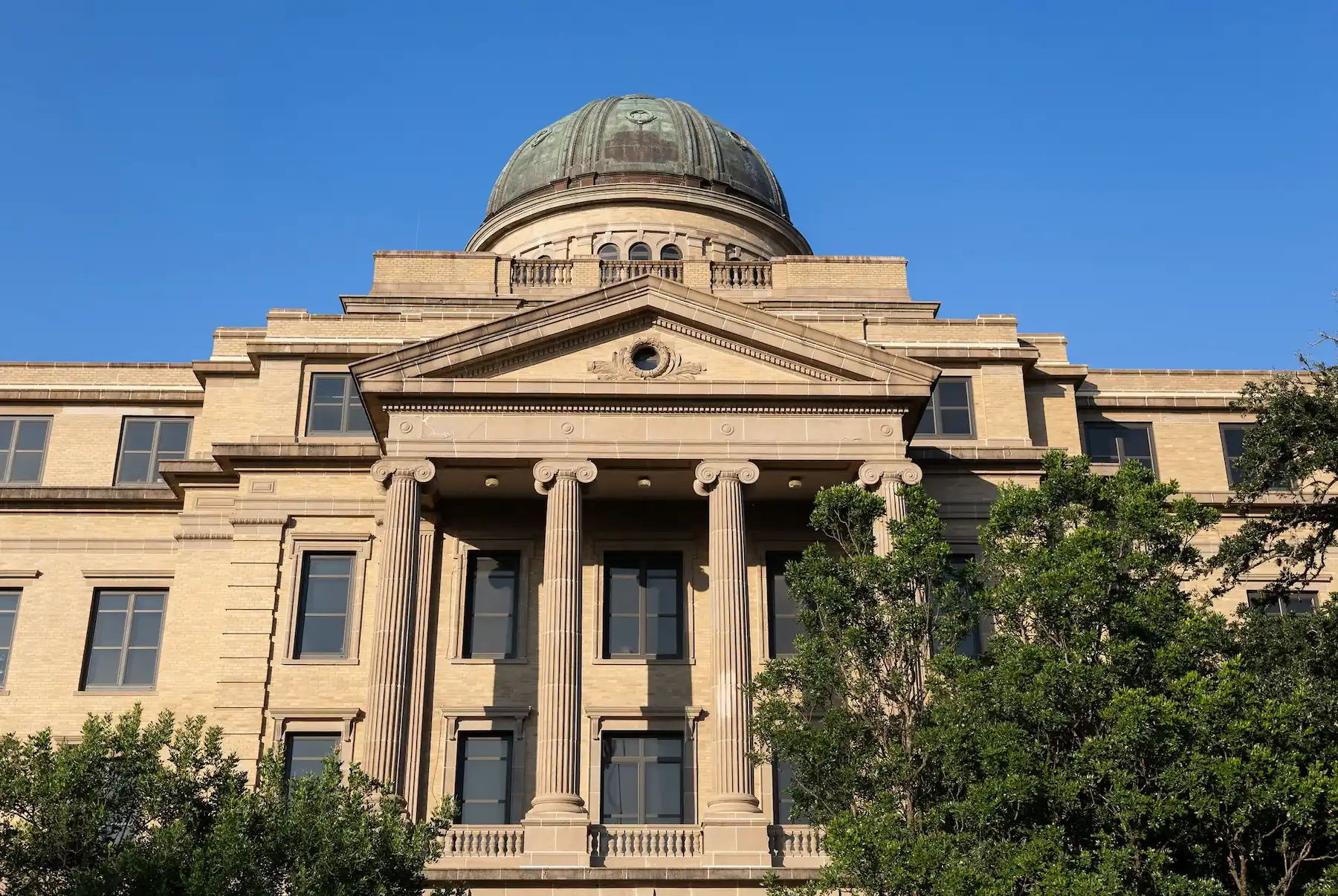The Texas A&M University System is one of six independent university systems in Texas. It educates over 165,000 students annually and employs more than 26,000 faculty and staff.
The Texas A&M University System operates with a budget of $7 billion and comprises 11 universities, eight state agencies, and a vocational training campus.
The system’s flagship institution is Texas A&M University in College Station, which was established in 1876 as an all-male military college. Originally it was called the Agricultural and Mechanical College of Texas — hence the acronym “A&M.”
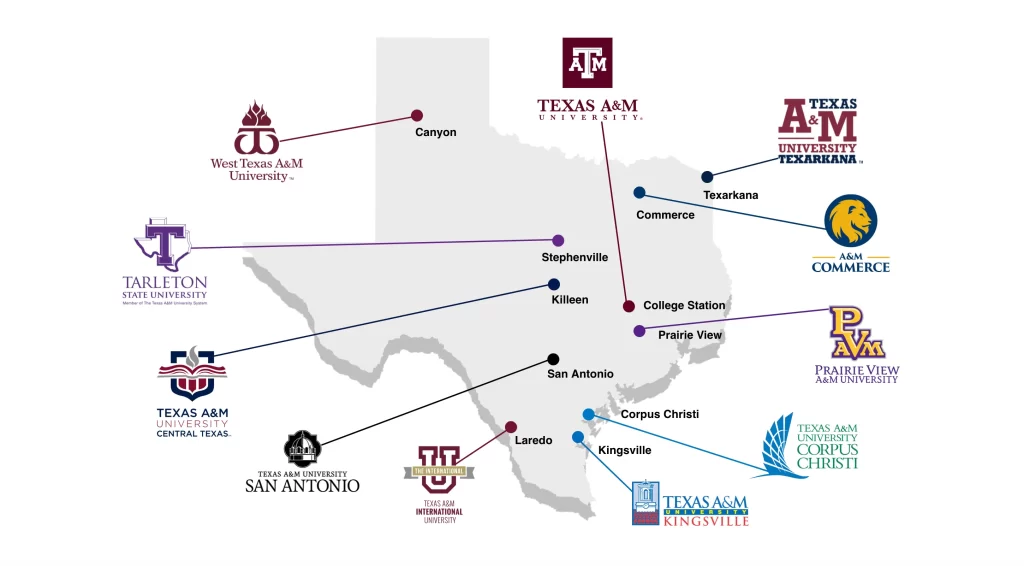
The other universities in the system are:
- Prairie View A&M University (near Houston)
- Tarleton State University (Stephenville)
- Texas A&M University–Corpus Christi
- Texas A&M University–Kingsville
- Texas A&M International University (Laredo)
- West Texas A&M University (Canyon/Amarillo)
- Texas A&M University–Central Texas (Killeen)
- Texas A&M University–Texarkana
- Texas A&M University–Commerce
Each institution within the Texas A&M System has its own mission, history, and goals, as well as a dedicated leadership team.
The Texas A&M University System offers a wide array of undergraduate and graduate programs designed to prepare students for success in various fields. With 11 universities and more than 152,000 students enrolled annually, the system provides diverse educational opportunities across the state of Texas.
At the College Station campus, the flagship institution, students can choose from over 130 undergraduate degree programs and 170 graduate programs across numerous disciplines. The university is particularly known for its strong programs in engineering, business, and agriculture, consistently ranking among the top schools in the nation for these fields. In addition to traditional degrees, Texas A&M University at College Station offers specialized programs in veterinary medicine, health sciences, and architecture.
Other universities within the Texas A&M System offer academic programs tailored to regional needs. For example, Texas A&M University-Corpus Christi is recognized for its marine biology and environmental scienceprograms, taking advantage of its coastal location. Texas A&M University-Texarkana offers strong programs in business and engineering, while Texas A&M University-Commerce focuses on education, social work, and business administration.
The system offers flexible learning options, including online degree programs and accelerated pathways, to accommodate working professionals and non-traditional students. These options are available at both the undergraduate and graduate levels, providing students with the ability to balance work, family, and education.
At the graduate level, the Texas A&M System offers a variety of master’s and doctoral programs. Texas A&M University in College Station leads with graduate programs in areas like business administration, engineering, education, and the humanities. Other campuses, such as Texas A&M University-Kingsville, offer specialized graduate programs in wildlife science and ranch management, while Texas A&M University-Central Texas provides programs in military studies and public administration.
Other universities within the Texas A&M System also offer academic programs tailored to regional needs. For example, the Corpus Christi campus is recognized for its marine biology and environmental science programs, taking advantage of its coastal location. The Texarkana campus offers strong programs in business and engineering, while the Commerce campus focuses on education, social work, and business administration.
The system offers flexible learning options, including online degree programs and accelerated pathways, to accommodate working professionals and non-traditional students. These options are available at both the undergraduate and graduate levels, providing students with the ability to balance work, family, and education.
At the graduate level, the Texas A&M System provides a range of master’s and doctoral programs. Texas A&M University in College Station leads with graduate programs in fields such as business administration, engineering, education, and the humanities. Other campuses, like Texas A&M University-Kingsville, offer specialized graduate programs in wildlife science and ranch management, while Texas A&M University-Central Texas provides programs in military studies and public administration.
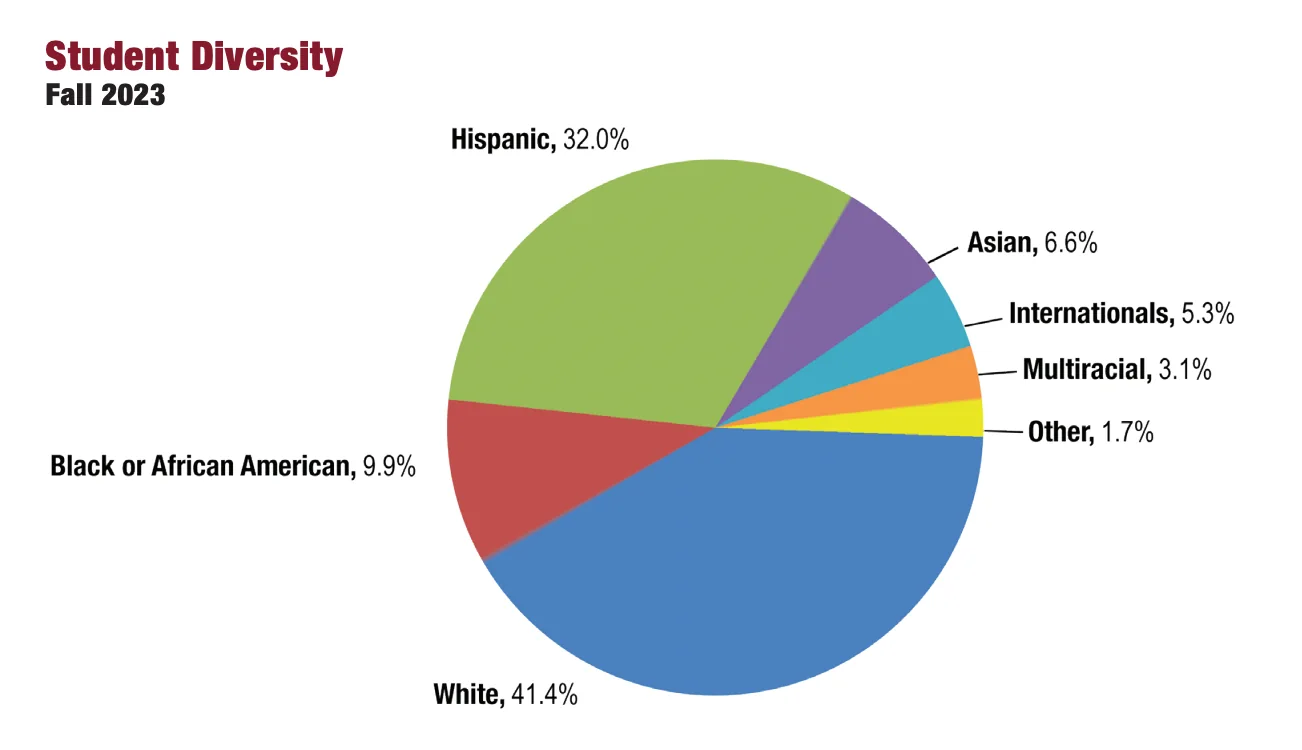
| University Name | Tuition + Fees (In-State) |
|---|---|
| Texas A&M University-College Station | $6,645 |
| Texas A&M University at Galveston | $6,431 |
| Texas A&M University-Central Texas | $3,608 |
| Texas A&M University-Commerce | $5,013 |
| Texas A&M University-San Antonio | $4,777 |
| Texas A&M University-Kingsville | $4,946 |
| Texas A&M University-Corpus Christi | $5,447 |
| Texas A&M University-Texarkana | $4,428 |
| Texas A&M International University | $4,725 |
Tuition and fees vary across the Texas A&M System. A student’s actual charges may vary based on the student’s classification and level of enrollment, the type of degree pursued, and the student’s specific personal circumstances.
The Texas A&M System is governed by a nine-member Board of Regents, appointed by the governor and confirmed by the Texas Senate for six-year terms.2 A nonvoting student member was added in 2006.
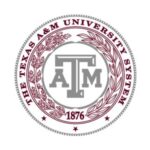
The A&M System chancellor oversees the day-to-day administration. He is supported by a 16-member executive committee.
The role of the A&M System headquarters is to oversee the administration and set policy direction for the system’s component institutions. It also plays a role in promoting academic research and technology, and liaising with higher levels of government.
In addition to the universities, the Texas A&M University System boasts eight state agencies with missions ranging from research to protecting natural resources and communities.

Texas A&M AgriLife Research (formerly the Texas Agricultural Experiment Station) was established in 1887. It represents a state-federal partnership in agricultural research.
Texas A&M AgriLife Extension (formerly the Texas Agricultural Extension Service) grew out of the agricultural initiatives of Texas A&M University under the provisions of the Smith-Lever Act of 1914, which provided for cooperative agricultural extension work between Texas land-grant colleges and the United States Department of Agriculture.
Texas A&M Forest Service was established in 1914, as a way to provide resources to develop and protect the forested areas of Texas.
Texas A&M Veterinary Medical Diagnostic Laboratory was created during the regular session of the 60th Legislature, in 1967; the lab formally opened in College Station in 1969.
The Texas A&M Engineering Experiment Station was also created in 1914 with a research and technology transfer mission for the field of engineering.
Texas A&M Engineering Extension Service, established in 1919, is dedicated to helping develop a skilled workforce through technical and vocational training.
Texas A&M Transportation Institute, created in 1950, conducts highway, safety, and other transportation-related research.
In 2019, the Texas Division of Emergency Management joined the A&M System as its eighth state agency. TDEM has roots in the civil defense programs established during World War II. The agency responds to disasters like hurricanes, floods, and the Covid-19 pandemic.
The Texas A&M University System has endowments valued at approximately $20 billion,3 the second highest among U.S. public universities after the University of Texas System and the University of California System. Texas A&M actually has two endowments. The smaller fund is run by the Texas A&M University System, and a larger fund is part of the Texas Permanent University Fund, in which TAMU holds a one-third stake.
The Texas A&M University System is a land-grant institution, which means it has been designated to receive the benefits of the federal Morrill Acts of 1862 and 1890. Those laws established a system of distributing proceeds from the sales of federally-owned land to support higher education institutions in the states.
The original mission of these institutions, as set forth in the first Morrill Act, was to teach agriculture, military tactics and the mechanical arts, as well as classical studies so that members of the working classes could obtain a practical education. Texas A&M seeks to honor its land-grant tradition by emphasizing affordability as a strategic goal.
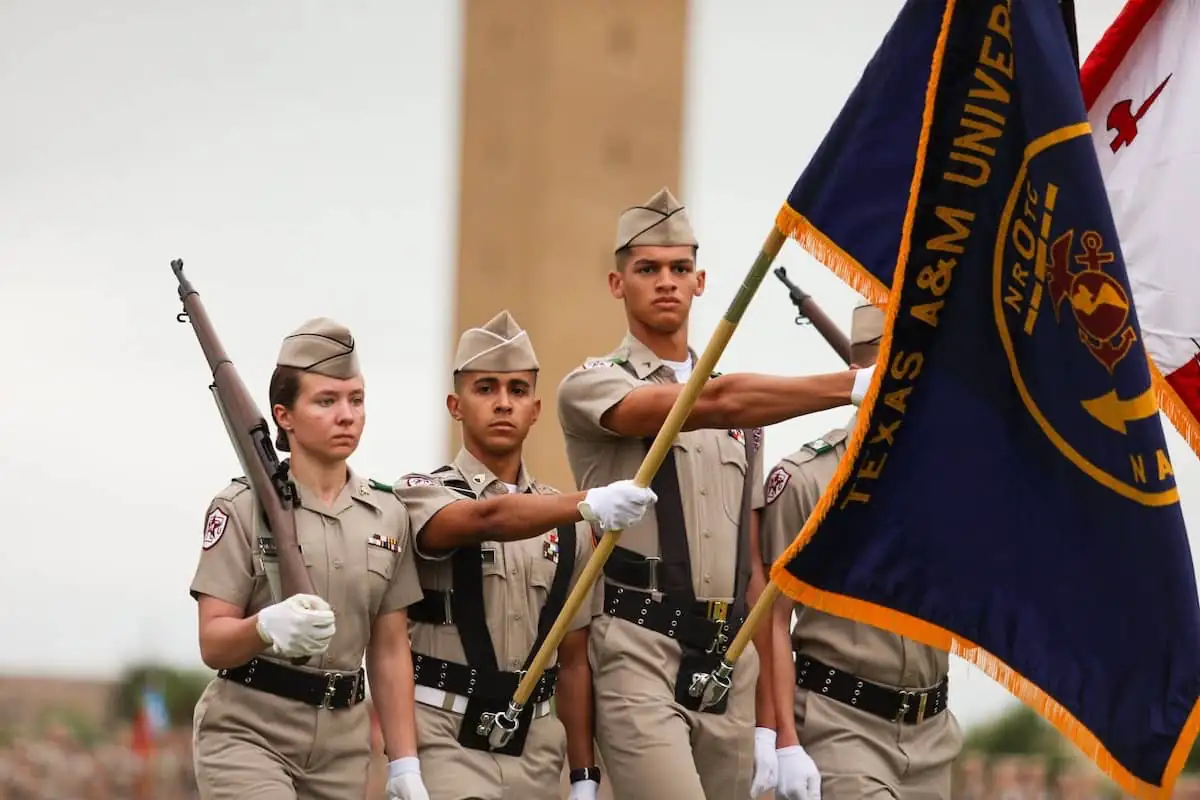
The Corps of Cadets is a student-led, military-style organization at Texas A&M. It is the oldest student organization on campus and was established with the university in 1876. Participation in the Corps of Cadets was mandatory until 1965.
The Corps of Cadets has a long tradition of preparing students for military service. Texas A&M consistently commissions more officers into the country’s military than any other school in the nation except the three service academies.
However, membership in the Corps of Cadets formally carries no military obligation. The Corps of Cadets also has programs designed to prepare cadets for leadership in the corporate sector or civilian government.
Historically it stood for “Agricultural and Mechanical,” because the university was established in 1875 as the Agricultural and Mechanical College of Texas. The university’s mission now goes beyond agricultural and mechanical education and the “A&M” officially no longer stands for anything. However, the university has retained that name in deference to the institution’s history and traditions.
The Texas A&M System was officially established in 1948, though the oldest member institutions had already existed for more than 70 years.
No. Students must contact directly the preferred A&M System institution’s admission office.
The Aggie Ring is a long-standing tradition at Texas A&M University, symbolizing a student’s achievement. Over 400,000 rings have been awarded since its creation in 1889. It’s considered a major milestone for Aggie graduates and a symbol of pride.
Aggie Muster is the largest student-run memorial service globally, held annually on April 21st to honor deceased Aggies. With over 200 locations worldwide, it’s a unique tradition where students gather to call the names of fallen alumni and respond “Here.”
The College of Engineering at Texas A&M, with nearly 20,000 students, is the largest in the U.S. by student enrollment. It offers over 15 different engineering disciplines and produces some of the country’s top graduates in fields such as civil, mechanical, and electrical engineering.
Each year, over 15,000 students graduate from Texas A&M University. These graduates go on to careers in a variety of industries, including engineering, business, healthcare, and public service.
The “12th Man” tradition at Texas A&M is one of the most famous in college sports. It began in 1922 when a student, E. King Gill, was called from the stands to suit up for the football team during an injury crisis. Ever since, the “12th Man” has symbolized the support of every Aggie, ready to step up for their team at any moment. It’s a key part of Texas A&M’s sports culture and pride. For students, being part of the 12th Man involves showing unwavering support for the team, attending games, and, in spirit, always being ready to contribute—whether on the field or in the stands.
Sources Cited
- Texas Higher Education Coordinating Board IFRS Tuition & Fees (2023) ↩︎
- Texas Education Code § 85.11 ↩︎
- “U.S. and Canadian 2024 NCSE Participating Institutions Listed by Fiscal Year 2024 Endowment Market Value.” National Association of College and University Business Officers (NACUBO). February 12, 2025. Total includes the endowment assets from The Texas A&M University System and multiple supporting foundations, including the Texas A&M Foundation, the Texas A&M University System, the Baylor Oral Health Foundation (which provides financial support to the Texas A&M University Baylor College of Dentistry), etc. ↩︎
